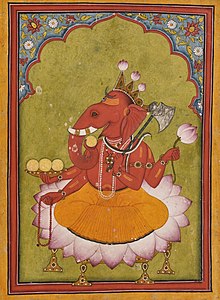
Ganesha
Hindu god of new beginnings, wisdom and luck / From Wikipedia, the free encyclopedia
Dear Wikiwand AI, let's keep it short by simply answering these key questions:
Can you list the top facts and stats about Ganesha?
Summarize this article for a 10 year old
Ganesha (Sanskrit: गणेश, IAST: Gaṇeśa), also spelled Ganesh, and also known as Ganapati, Vinayaka, and Pillaiyar, is one of the best-known and most worshipped deities in the Hindu pantheon[4] and is the Supreme God in the Ganapatya sect. His depictions are found throughout India.[5] Hindu denominations worship him regardless of affiliations.[6] Devotion to Ganesha is widely diffused and extends to Jains and Buddhists and beyond India.[7]
| Ganesha | |
|---|---|
 | |
| Affiliation | Deva, Brahman (Ganapatya), Saguna Brahman (Panchayatana puja) |
| Abode | • Mount Kailash (with parents) • Svānandaloka |
| Mantra | Oṃ Shri Gaṇeśāya Namaḥ Oṃ Gaṃ Gaṇapataye Namaḥ |
| Weapon | Paraśu (axe), pāśa (noose), aṅkuśa (elephant goad) |
| Symbols | Swastika, Om, Modak |
| Day | Tuesday or Wednesday, Sankashti Chaturthi |
| Mount | Mouse |
| Texts | Ganesha Purana, Mudgala Purana, Ganapati Atharvashirsa |
| Gender | Male |
| Festivals | Ganesh Chaturthi, Ganesh Jayanti |
| Personal information | |
| Parents | |
| Siblings | Kartikeya (brother) |
| Consort | Buddhi, Riddhi and Siddhi or celibate in some traditions |
| Equivalents | |
| Japanese Buddhist equivalent | Kangiten |
Although Ganesha has many attributes, he is readily identified by his elephant head and four arms.[8] He is widely revered, more specifically, as the remover of obstacles and thought to bring good luck;[9][10] the patron of arts and sciences; and the deva of intellect and wisdom.[11] As the god of beginnings, he is honoured at the start of rites and ceremonies. Ganesha is also invoked as a patron of letters and learning during writing sessions.[2][12] Several texts relate anecdotes associated with his birth and exploits.
Ganesha is mentioned in Hindu texts between the 1st century BCE and 2nd century CE, and a few Ganesh images from the 4th and 5th centuries CE have been documented by scholars.[13] Hindu texts identify him as the son of Parvati and Shiva of the Shaivism tradition, but he is a pan-Hindu god found in its various traditions.[14][15] In the Ganapatya tradition of Hinduism, Ganesha is the Supreme Being.[16] The principal texts on Ganesha include the Ganesha Purana, the Mudgala Purana and the Ganapati Atharvasirsha.